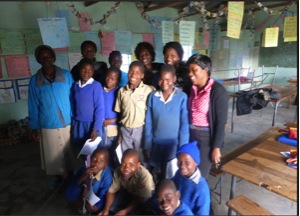Tags
"children"
Elementary School Psychology: Maggie MacLean, Winter Shadow 2016
I participated in a two-day shadow with Moira Tofanelli, a school psychologist at two different public schools in Portland. As an art major completing a thesis that draws heavily from the field of psychology, I was excited to see where a career in psychology could take me in Portland. I will be graduating in May and I am thinking about what kind of job I would like in the near future, and teaching seems to be an obvious next step for me. It was a great exercise for me to think about what kind of school I want to be a part of and see how the public schools in Portland vary.
It was interesting for me to compare the two schools I visited, as they were very different in terms of philosophy and educational goals. In the developmental psychology class I am taking this spring, we have been focusing on different models of human development and the kinds of guidance and parenting strategies that support each model. The first school I visited, the Creative Science School, uses a constructivist educational perspective. Jean Piaget, a psychologist influential in the 1970s, is the best-known proponent of this philosophy. Constructivism values learning through experience and independent problem solving. In general, Piaget viewed child development as a series of stages, and children as tiny scientists who learn about their world through experimentation and add new information to existing mental schemas. In the classroom, a constructivist approach often manifests as lots of group work, experiential projects, and integration of different classroom subjects.
To me, Creative Science seems big and colorful and full of movement and the evidence of children. There are art projects all over the hallway walls, glitter-covered handprints, and photographs of the students. I had forgotten what it is like to be in an elementary school. Everything is kid sized and chaotic in the way things are when tiny humans spend six hours a day in an enclosed space.
Continue reading Elementary School Psychology: Maggie MacLean, Winter Shadow 2016
Winter Externship 2015, Speech and Language Pathology with Daniela Deyoung,Qingyang Xie
This past winter (2014), I shadowed Daniela Deyoung, a speech and language pathologist at the Portland Public School Early Childhood Team, for two weeks in January. Dani is mainly in charge of the transition from preschool to kindergarten for children with development delays, so she not only does speech development evaluations, but also communicates with preschool and kindergarten teachers and therapists to help with a smooth transition for children with special needs at school. Dani works with both English and Spanish speaking children. I followed Dani around the city to different meetings with parents and school staff and to observation sessions of children who need evaluations. Thanks to Dani, I also got to observe her colleagues during their evaluation sessions of children who were brought to the Early Childhood Team by parents with concerns of language or general development delay. It was very exciting and fun to learn about the child language development and observe the diverse tasks she and her colleagues perform on a day to day basis. Everyone was very friendly and helpful and was very patient with my questions.
I applied to the externship because I am very interested in languages and would like to learn more about the language development process of children. It was also a great opportunity to explore a completely new field. Dani was very engaged and helpful in the process and I learned a lot about autism and typical and non-typical child development at different age groups. Since Dani works with many children who fall in the autism spectrum, she started sending me articles about autism spectrum before the externship started and familiarized me with the symptoms. She was a great teacher and pointed out the children’s behaviors that might be indicators of autism to me during the observation sessions. She also gave me the opportunity to apply the autistic symptoms I learned by taking observation notes and gave me detailed feedback on them. I learned a great deal about child development from her within two weeks.
One important thing I learned is the importance of child play. Child play is an indicator of children’s social skills, their motor development and their intelligence development in general. Child play should be functional, meaning that children should play the toys the way they are designed to be played, have a story about what they are playing, or use the toys in innovative but still sensible ways. It is a lot of the times an imitation of adults’ activities—like cooking, driving cars, building a house, etc—and sometimes require cooperation with other children. When a child is not playing functionally, but uses a toy to make repetitive movements such as dragging a train in a circle nonstop or staring at car’s wheels spinning, it might be an indicator of autism, but of course the language pathologist has to see other symptoms of autism to qualify the child for special education. It was fascinating for me to learn about the functions and complexity of child play and helped me understand the typical behaviors of children.
Continue reading Winter Externship 2015, Speech and Language Pathology with Daniela Deyoung,Qingyang Xie
Presidents Summer Fellowship, Art Therapy in Italy Part 3, Margaret MacLean

President's Summer Fellow Margaret MacLean '16, studio art major, is leading art classes for youth with intellectual and developmental challenges at the Cooperativa Barberi in Florence, Italy. Read on for the third installment of her adventures:
It is so strange to be back in Portland away from the hustle and bustle of Florence. I realize that I felt very big in Florence in a wide-clunky-taking-up-space sort of way. Biking to work or class I was constantly dodging tourists, locals, and dogs on narrow streets. Coffee is served in the smallest of cups. Kitchen appliances are tiny. Doorways are smaller than in the US, chairs and tables are lower, and there is always a stranger’s elbow to accidentally bump into. Being back in Portland I feel like I have space to breathe, but I still miss the chaos.
Davis Project for Peace, Celebrity Nyikadzino: Sewing and self reliance in Chivhu, Zimbabwe,

A Stitch in Time
This summer I am at home in Chivhu, Zimbabwe, implementing a sewing project, which we named A step toward hope— Education and self reliance. With the help of a local teacher, my family, and various community members, we are teaching 16 primary-age children how to sew. In addition to that we are also teaching them business skills as well as fostering a good environment for friendship making. Poverty is a major threat to peace in my village, and the main aim of this project is to alleviate the effects of poverty and to make sure the children stay in school. We hope that at the end of the day, the children can competently take care of themselves as well as help others in need.
Prior to the start of the project in mid-June, there was great interest in taking part in the project. To my chagrin, the headmistress of Chivhu Primary had already identified and recommended more than 70 students who could benefit from it. These children come from low-income families and more than half of them were orphaned. This situation was really hard since at most we could only accommodate 15 children. We eventually decided to choose the children based on academic skill, and also weighing who had the most probability of dropping out of school. We ended up with 16 of the least academically gifted children in the reasoning that they will be able to sustain themselves in the event that they fail in school. Four of these were currently not in school at all.
